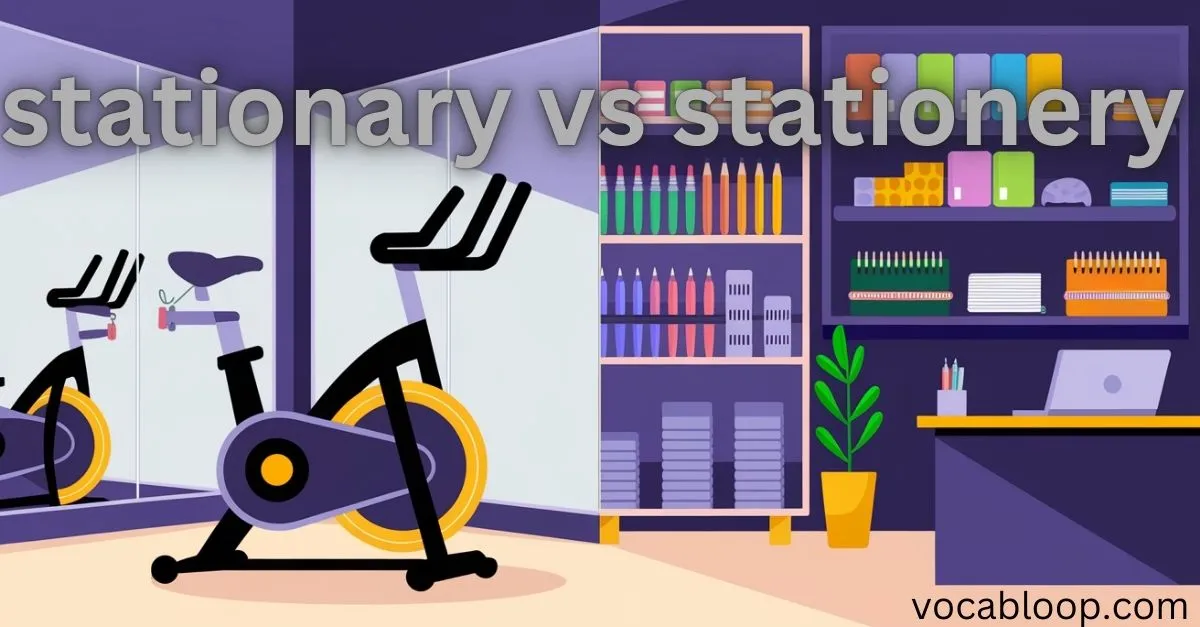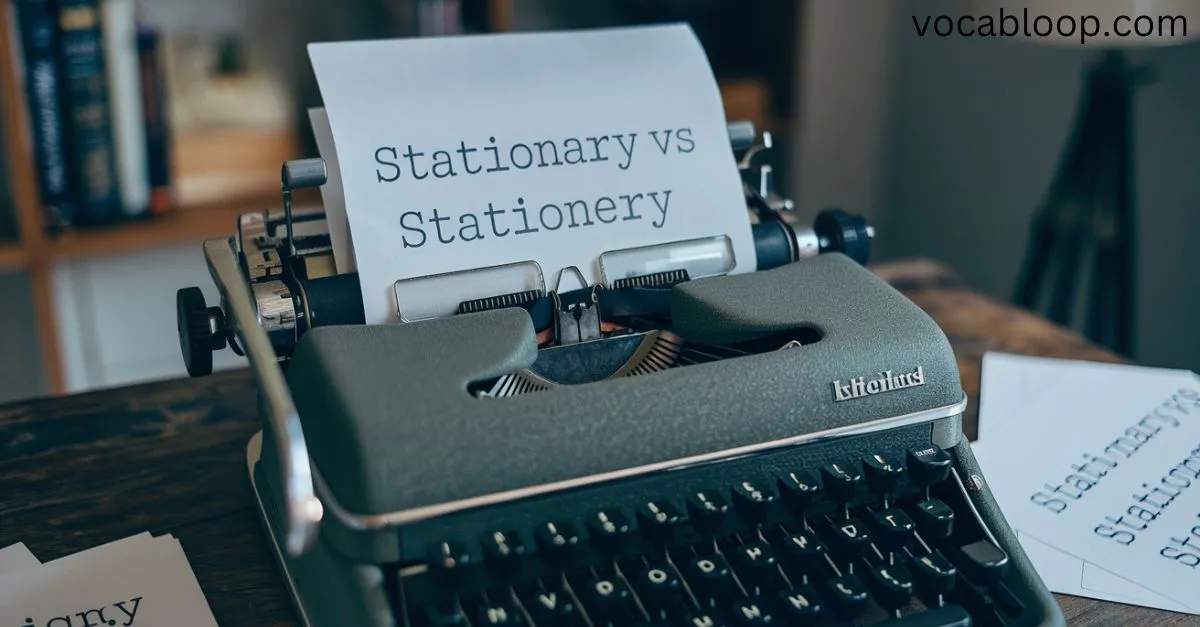Stationary vs Stationery is one of the most persistent grammar pitfalls in English. These two commonly confused words sound the same, but their meanings couldn’t be more different. Writers, students, and professionals often get tripped up by this language mix-up, but understanding the difference can sharpen your grammar and language rules and improve your writing clarity.
In this article, we’ll explore the definitions, meanings, and uses of these words, offering real-time suggestions and practical tips to help you avoid mistakes. You’ll also discover tricks to remember the distinction and how tools like Grammarly AI features and other writing assistants can enhance your writing techniques.
What is the confusion between stationary vs stationery?

The confusion arises because “stationary” and “stationery” are homophones—they sound the same but differ in meaning and spelling. The problem becomes worse when people write quickly or don’t double-check their spelling.
While stationary refers to something fixed or immobile, stationery is related to writing supplies like envelopes, paper goods, and pens. This difference in meaning is subtle yet significant, making it crucial to grasp their proper usage to avoid being misunderstood.
What is stationary?
Definition
The word stationary is defined as “not moving” or “fixed in one place.” It comes from the Latin word stationarius, which means “belonging to a post or station.” This word has retained its core meaning over centuries, emphasizing the state of being still or unchanging.
Meaning
Stationary describes objects or situations that remain immobile or static. For example, a statue in a park or a car stuck in traffic is stationary. This word is often used in contexts related to physical stillness, like immobile objects or fixed examples, such as stationary traffic during a red light.
Usage
Stationary refers to anything that remains fixed or unmoving. For example, “The car remained stationary at the intersection, waiting for the light to change.” It’s used to describe objects that don’t change position, like a statue in a park or a book on a shelf that stays put. This term is crucial in contexts where stillness or immobility is necessary to convey meaning.
What is stationery?

Definition
The word stationery refers to writing materials or office supplies. It includes items like writing supplies, stationery sets, envelopes, pens, and decorative paper. The term comes from the Old French word estacionarie, referring to a stationer—a person selling writing tools.
Meaning
Stationery is associated with all things used for writing or correspondence. If you’re sending a letter, you’ll need stationery products like quality paper and an envelope. It’s a word often seen in offices, schools, and personal projects where writing materials play a role.
Usage
Stationery refers to writing materials, office supplies, and related items such as pens, paper, envelopes, and notepads. It is commonly used in business and personal correspondence. For example, when writing a letter, you would typically need quality stationery products like a pen and paper.
It’s also used for invitations, greeting cards, and custom-designed stationery sets for special occasions. This term encompasses all the tools needed for effective communication in writing.
Quick summary
| Word | Definition | Examples |
| Stationary | Not moving; fixed or immobile | A stationary car, a still object |
| Stationery | Writing materials or supplies | Pens, notebooks, envelopes |
This table highlights the meaning distinction and makes the comparison of terms easier to understand.
Stationary vs stationery as parts of speech
Stationary functions as an adjective, describing the state of being still or unchanging. Meanwhile, stationery is a noun that refers to physical objects used for writing or correspondence. This grammatical difference is an important part of understanding their usage in sentences.
Pronunciation of stationary vs stationery

Despite their differences in spelling, both words are pronounced the same: /ˈsteɪʃəˌneri/. This identical pronunciation adds to the confusion and makes spelling errors more likely. To avoid mistakes, pay attention to the context in which the word is used. For instance, stationery products are tangible, while something stationary is intangible and unmoving.
Side-by-Side Comparison stationary vs stationery
| Aspect | Stationary | Stationery |
| Definition | Not moving or unchanging | Writing supplies |
| Part of Speech | Adjective | Noun |
| Examples of Usage | Stationary bike, still air | Pens, paper, envelopes |
| Context | Immobility, fixed objects | Writing tools, office items |
This comparison of terms highlights their unique roles and contexts.
Which one is more acceptable: stationary vs stationery?
Both words are acceptable but only when used correctly. For example, describing a pen as “stationary” instead of “stationery” is incorrect because it changes the meaning entirely. Grammar advice from reliable sources can help you master this difference. Using live proofreading tools like Grammarly ensures fewer errors in real-time.
Stationary in British English and American English
In both British and American English, the word stationary carries the same meaning: “not moving” or “fixed.” This consistency makes it easier to use in various contexts. However, British English often associates “stationary” with formal writing, such as describing traffic conditions: “The cars remained stationary for hours.”
In American English, “stationary” is more commonly used in everyday language. For instance, someone might say, “The exercise bike is stationary,” to describe a fitness tool that doesn’t move. Despite subtle differences in usage frequency, the word’s syntax rules remain identical in both regions.
Stationery in British English and American English
The word stationery, referring to writing supplies like stationery sets and envelopes, is also used consistently in British and American English. However, preferences for specific paper goods or writing materials might vary slightly.
For example, British English leans towards more ornate or decorative stationery, often used for personal correspondence. Meanwhile, American English prioritizes functional stationery products for business use, such as letterhead paper or branded notepads. These subtle variations highlight cultural preferences without altering the word’s core meaning.
Common mistake: How to avoid from them
Mixing up stationary and stationery is one of the most frequently misused words in English. To avoid this error, always consider the context. Ask yourself: Is it describing something still, or does it refer to writing tools? This mental check can save you from making embarrassing grammar differences in your writing.
Another helpful strategy is to rely on AI proofreading tools. Apps like Grammarly provide instant feedback and flag incorrect usages of these words. With these smart writing aids, you’ll receive live proofreading and corrections to improve your writing on the spot.
Trick to Remember the Difference stationary vs stationery
An easy way to remember the distinction is with this mnemonic: StationAry means stAnding still, while StationEry is for Envelopes. Focusing on the vowels “A” for immobility and “E” for writing materials makes it simple to keep them straight.
Another trick is visual association. Think of “stationAry” as a stationary bike that doesn’t move. For “stationEry,” imagine an envelope, which starts with “E,” and reminds you of stationery products like pens, notebooks, and stationery sets.
Origins of stationary vs stationery

The word stationary originates from the Latin term stationarius, meaning “belonging to a station.” Initially, it described soldiers who remained in one place, emphasizing the concept of immobility. Over time, the term broadened to include anything that doesn’t move, such as fixed objects or static conditions. This evolution reflects its use in describing physical objects and situations that are not dynamic.
On the other hand, stationery has its roots in the Middle English word stationer, which referred to booksellers or merchants selling writing tools and materials. These sellers were stationary, focusing on providing writing supplies. Over time, the term expanded to encompass all paper goods, including pens, paper, envelopes, and other writing tools. This evolution highlights the word’s association with writing and correspondence, marking its development from a specialized trade to a general term for all writing materials.
Synonyms of stationary vs stationery
stationary:
- Immobile
- Fixed
- Motionless
- Unmoving
- Still
- Static
- Inactive
- Anchored
- Rooted
- Unchanging
stationery:
- Writing materials
- Office supplies
- Paper goods
- Envelopes
- Letterhead
- Notepads
- Stationery sets
- Pens
- Paper stock
- Greeting cards
Sentences in daily usage of stationary vs stationery
Stationary:
- The car remained stationary at the red light.
- The statue in the park is stationary.
- My bike is stationary because it has a flat tire.
- The flag stayed stationary despite the wind.
- She kept the ladder stationary while I climbed.
- The planet appeared stationary from our viewpoint.
- His career seemed stationary for years.
- The ball remained stationary on the flat surface.
- The clock hands were stationary due to a malfunction.
- The satellite stayed stationary in orbit.
Stationery:
- I bought new stationery for my office.
- Her stationery set included beautiful envelopes.
- He writes letters using fancy stationery.
- I ran out of stationery while working on invitations.
- The store sells pens, paper, and other stationery.
- My desk drawer is full of unused stationery.
- She gifted me a box of decorative stationery.
- Stationery products make great gifts for students.
- The wedding invitations required custom stationery.
- Personalized stationery adds a nice touch to letters.
FAQs
What is the main difference between stationary and stationery?
Stationary means still or fixed, while stationery refers to writing supplies like paper and pens.
Can stationary be used as a noun?
No, stationary is strictly an adjective and cannot function as a noun.
Is stationery ever plural?
Stationery is typically uncountable, but it can refer to various items collectively, like “a set of stationery.”
Why do stationary and stationery sound the same?
They are homophones, meaning they share pronunciation but differ in spelling and meaning.
What tools can help avoid confusing these words?
Tools like Grammarly’s grammar checker provide real-time suggestions and ensure linguistic accuracy.
Conclusion
Stationary vs Stationery, it’s helpful to practice with real-world examples. Incorporating these words into sentences and using mnemonic devices can make the difference clear.
By making a conscious effort to understand and use these terms correctly, you can improve your writing skills and avoid the common confusion that often leads to mistakes in everyday communication.

Alex Hormozi is a seasoned blogger at Vocab Loop, known for his deep insights into language, vocabulary, and grammar. With years of experience in writing, Alex shares practical tips and effective strategies to help readers improve their linguistic skills and enhance their writing abilities.

